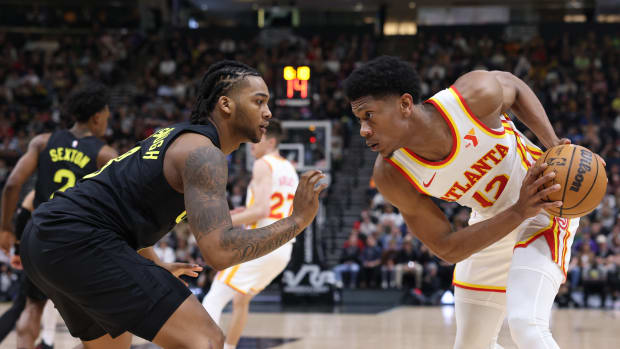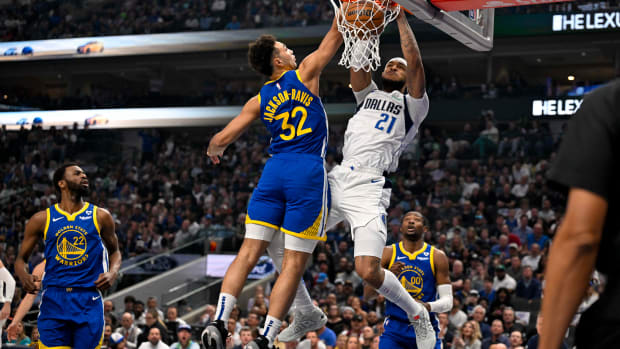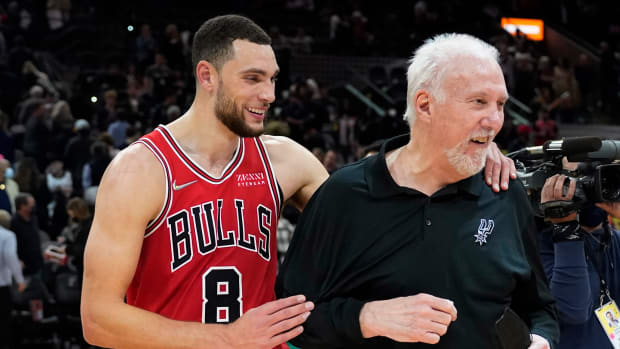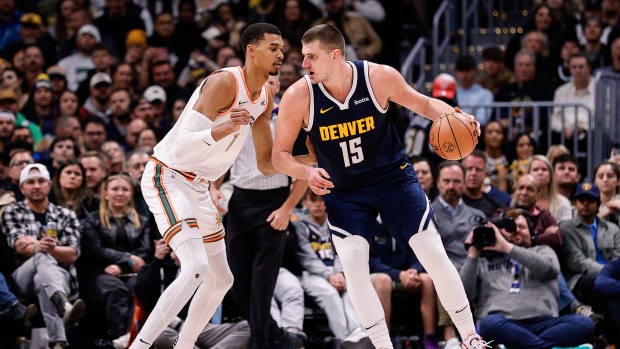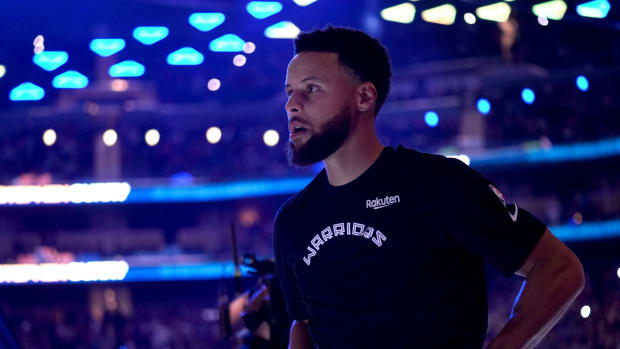Top 100 NBA Players of 2019: Biggest Snubs
Creating a defined list inevitably leads to snubs, the likes of which run deep with our ranking of Top 100 NBA Players of 2019.
In some sense, stopping at 100 is an arbitrary end point. There isn't a dramatic difference between our final pick and those players who narrowly missed the cut, and one could make a compelling case for many of those omitted to claim one of the last spots. Beyond that, there are handfuls of relevant players who are well regarded but noticeably absent, unseated by the sheer number of qualified candidates. The list below is a combination of those two groups—a collection of 25 notable omissions, though not squarely a queue of those players next in line. In alphabetical order:
Carmelo Anthony, Rockets
Melo has a way of making things complicated. At 34 years old, he presents the value of a role player but demands the consideration of a star. The very suggestion that he might come off the bench—an idea only proven reasonable with time—was treated as a joke. Some other attempts to transition his game have been met with resistance. Anthony (16.2 PPG, 5.8 RPG, 1.3 APG) still has something to offer as a scorer, but perhaps not as much as he thinks.
This creates a sort of double handicap, taxing a team not only for what Anthony does poorly (notably: defense), but also for those things he believes he still does well. Consider this: Of all the players to take 15 shots per game or more last season, Anthony finished dead last in true shooting percentage. This is his career’s reckoning. There is no future for him as a go-to scorer, or even a secondary one. But if he were to shape his Hall of Fame credentials to a slighter role, Anthony may yet have the last laugh. — RM
Malcolm Brogdon, Bucks
Brogdon (13 PPG, 3.3 RPG, 3.2 APG) was dubbed “The President” back when that moniker still connoted composure, thoughtfulness and dignity. Times have changed, but the 25-year-old guard remains a steadying presence for the Bucks, who missed him badly when he was sidelined for two months with a quad injury last season. Blessed with good size, a reliable three-point stroke and a solid understanding of how to initiate the offense, the 2017 Rookie of the Year will be a player to watch under new coach Mike Budenholzer. Brogdon’s catch-and-shoot ability will be crucial for maximizing spacing around Giannis Antetokounmpo, and his unselfish, low-turnover approach will help Milwaukee’s franchise forward be deployed in a wider variety of off-ball looks. — BG
Kentavious Caldwell-Pope, Lakers
In the right light, Caldwell-Pope (13.4 PPG, 5.2 RPG, 2.2 APG) looks like a nice, up-and-coming three-and-D wing. Reality is more sobering. Last year was the first above-average three-point shooting season of Caldwell-Pope’s career and also his most negligent defensively. He’s had good shooting days and impressive defensive performances, but rarely do they seem to coincide; the most crucial dimensions of Caldwell-Pope’s play are simply too erratic to be reliable. This would seem rather inconvenient for a team with playoff aspirations, as the Lakers may soon find. Caldwell-Pope doesn’t lack for ability—only the consistency of performance and focus common to the NBA’s best role players. — RM
Jae Crowder, Jazz
For Crowder (9.7 PPG, 3.4 RPG, 1.2 APG) to again make the Top 100 on his 3-and-D merits, he’ll need to make more than 32.3% of his threes and actually defend for more than a few months. Even his move to Utah didn’t quite have the expected effect; Crowder’s shooting percentages, already some of the worst of his career, only went down as he transitioned from the Cavs to the Jazz. The most meaningful contribution he made all year was to hold a post in what was already a stout defense. Crowder can do better—we just need to see it. — RM
Spencer Dinwiddie, Nets
As a general rule, any player shooting worse than 40% from the field needs some undeniable contributions to make the cut. Dinwiddie (12.6 PPG, 3.2 RPG, 6.6 APG) falls short. He was so often the best thing the Nets had going last season, which in a sense was part of the problem; a lack of shot creators clearly forced Dinwiddie into a larger role than is most comfortable. What makes his assessment more difficult than most is his limited body of work. The best we’ve ever seen Dinwiddie play came in a starting role he wouldn’t have had under normal circumstances, gunning his way through the season because there were no better options. It was a strange year. On-court impact made him a borderline case, regardless, though a more efficient season could help punch his ticket. — RM
Tyreke Evans, Pacers
Based solely on his play last season, Evans (19.4 PPG, 5.1 RPG, 5.2 APG) would have been an easy pick for the Top 100. The 28-year-old scoring guard was a rare bright spot for the Grizzlies, posting a career-high PER, shooting a career-best 39.9% on threes, and notching his best scoring average since his 2010 Rookie of the Year campaign. Despite winning just 22 games, Memphis even managed to outscore its opponents when Evans was on the court. But therein lies the rub: Evans missed 30 games last season and has now missed an average of 43 over the last three years. His move to Indiana makes sense on multiple levels. Evans will enjoy playing for a team that isn’t tanking, he will help release pressure as a secondary playmaker, and he will fill a major need as a lead initiator when Victor Oladipo goes to the bench. His ability to stay healthy, then, should be viewed as one of the East’s biggest X-factors. — BG
Markelle Fultz, Sixers
Fultz (7.1 PPG, 3.1 RPG, 3.8 APG) is Exhibit A for why The Crossover has elected not to include rookies in the annual Top 100 rankings: No one can predict exactly how a college or international player will adapt to an 82-game schedule and the NBA lifestyle. Needless to say, the 2017 No. 1 pick had the least predictable rookie season in recent memory, playing just 253 minutes over 14 games while leaving the Sixers for stretches amid questions about his injured shoulder, altered shooting mechanics and mental readiness. Pegged as a lead guard who could score at all three levels, the 20-year-old Fultz didn’t hit a single three-pointer, hardly got to the line, and struggled to finish outside the basket area. Even so, the table is set for Fultz to reintroduce himself: He will have a clearly defined role, he will be surrounded by playoff talent, and he doesn’t need to carry a star’s burden on or off the court. Is he poised put his peculiar rookie odyssey behind him? — BG
Danilo Gallinari, Clippers
It’s been one ailment after another for Gallo, whose career could be signposted by torn ligaments and broken bones. The very notion of a “healthy Gallinari” is a myth. If he existed, he would be a top-100 player, no questions asked. Even this version is fairly close; 60 games or so from a functional Gallinari would give a team a solid basketball return, though the mystery of if and when he’ll be available is a significant ding to his case. The merits of his game are there. But as they say: 80% of making the Top 100 is just showing up. — RM
Marcin Gortat, Clippers
There is a virtue in players who just do their jobs, though not quite enough virtue in Gortat’s case to overcome the other regressions in his game. John Wall’s plea for an athletic big man was grounded in reality. Gortat (8.4 PPG, 7.6 RPG, 1.8 APG) looks slower by the year, which only makes it harder for him to find scoring opportunities. The same rolls to the rim that would have ended in a dunk a few seasons ago now sputter and stall. Gortat’s process hasn’t changed, only his tempo—and thus, the result. Moving a step slower also does no favor to Gortat’s already middling defense; Gortat has never been much of a leaper, but at least he could shuffle into the right spaces and contest shots on size alone. No longer—at least not on the scale of a playoff starter. — RM
Tim Hardaway Jr., Knicks
Hardaway (17.5 PPG, 3.9 RPG, 2.7 APG) is an altogether more useful player now than the last time he was a Knick, though there’s still a decent margin between the 26-year-old scorer and the cut for our list. It’s hard to make a Top 100 case for a player whose best attribute would scale down so dramatically on a winning team. Hardaway doesn’t have the game to be a primary scorer for a winning club. He may not be a secondary or tertiary scorer either; if anything, Hardaway’s skill set falls most in line with that of key reserve—one free to fire away with little penalty. Volume shooting looks good by the numbers and works fine for the Knicks. More competitive teams, however, have the kinds of priorities that would mitigate Hardaway’s production. — RM
Montrezl Harrell, Clippers
Harrell (11.0 PPG, 4.0 RPG, 1.0 APG) lives on overdrive, which serves him well in 17 minutes a game. Anything beyond 20, however, could be a stretch. The very things that make Harrell effective are the sort that fade through extended playing time. Hustle is finite. Even relentlessness has its limits. Assigning Harrell a larger role, then, risks turning a spark into a fizzle. What allows him to be an amazingly productive player on a per-minute basis is the knowledge that he never has to save anything for the swim back. Let Montrezl be Montrezl. He’s at his most effective and his most interesting playing all-out basketball in a smaller role, even if that means he’s unlikely to play enough to crack a ranking like this one. — RM
Buddy Hield, Kings
Kudos to Vlade Divac: The Kings not only failed to land a single player in the Top 100, they failed to have one seriously considered. Unless Marvin Bagley III hits the ground running, De’Aaron Fox takes a massive leap forward, or Bogdan Bogdanovic suddenly learns how to play competent defense, Hield (13.5 PPG, 3.9 RPG, 1.9 APG) is the most likely King to make next year’s list. The 24-year-old guard hasn’t yet played well enough to justify the DeMarcus Cousins trade, but he ramped up his scoring, three-point shooting and efficiency in his second season. Next up on the list of necessary improvements: getting to the line, developing an in-between game, consistently making plays for others, and holding his own while defending starting-caliber guards. — BG
George Hill, Cavaliers
Over the past year, Hill’s contributions (10.0 PPG, 2.7 RPG, 2.8 APG) went from quiet to invisible. Injury played a part, though Hill didn’t seem to have much of an influence on the game even when largely healthy. His attempts to create off the dribble stalled out. His shooting didn’t quite hold up. It was as if Hill finally became the player his critics always thought he was—as if his standout seasons in Indiana and Utah never happened. There’s a chance that a healthier Hill could pull it together, though gradual regression seems like the more plausible outcome. — RM
Enes Kanter, Knicks
There are three things that Kanter (14.1 PPG, 11 RPG, 1.5 APG) does very, very well: hit the offensive glass, finish in the basket area, and talk all sorts of unnecessary trash to superstars like LeBron and KD. He would get more credit for the first two—and less flak for his misguided Twitter barbs—if he could anchor a defense. Alas, that’s not going to happen because he’s an archaic big: too slow and clumsy to defend in space and too timid to truly protect the rim. Last season, the 26-year-old Turkish center allowed opponents to shoot 60.8% on shots within six feet. Only three centers allowed a higher percentage on an equal or greater number of shots: Karl-Anthony Towns, Nikola Jokic and Nikola Vucevic. If Kanter could hit the three like Towns or serve as a distributing fulcrum like Jokic, he would have a chance to deliver enough offensive value to offset his defensive limitations. Unfortunately, that’s an “if” that likely isn’t going to happen. — BG
Kyle Kuzma, Lakers
Kuzma (16.1 PPG, 6.3 RPG, 1.8 APG) was a fantastic find by the Lakers at No. 27 in the 2017 draft, but he’s probably become a touch overrated. During a stellar rookie season, he drew rave reviews as a confident scorer and a textbook stretch four, hitting threes in volume and attacking mismatches from the perimeter. Less discussed? The fact that Kuzma had an unremarkable impact on his team’s offensive efficiency, and that he was a minus defender who lacks both the lateral quickness to handle wings and the length to be an interior force. If he was 19, a generous observer might be able to project him developing into a two-way contributor. Kuzma is already 23, though, and appears destined to become a situational frontcourt scorer with the ability to break open a game when he’s hot. — BG
Zach LaVine, Bulls
There isn’t much evidence to date that LaVine’s particular brand of scoring is all that conducive to healthy offense. The man can shoot—his form itself is one of the most elegant in the league—but he tends to subsist on empty-calorie jumpers without actually applying much pressure. Were he getting to the basket or drawing fouls more often, LaVine might buoy his efficiency enough to break through. That just hasn’t happened, and only seems less likely as LaVine continues to work his way back from an ACL tear. Playing some occasional defense wouldn’t hurt, either. — RM
Jabari Parker, Bulls
Did the Bulls think with their heads or their hearts when they signed Parker (12.6 PPG, 4.9 RPG, 1.9 APG) to a two-year, $40 million contract this summer? Emotionally, his Chicago homecoming and post-injury redemption are tempting storylines. Logically, however, the 23-year-old forward is a walking red flag: He’s missed 30+ games in three of his four seasons, he’s suffered two season-ending ACL tears, he’s been a clear minus defender throughout his NBA career, and he’s a tricky player to fit into an efficient team offense. To justify his new contract, the 2014 No. 2 pick will need to establish himself as an efficient alpha scorer who consistently requires extra defensive attention. We’ll see. — BG
Andre Roberson, Thunder
When healthy, Roberson (5.0 PPG, 4.7 RPG, 1.2 APG) is the rare wing stifling enough to contend for Defensive Player of the Year. The trouble is that he isn’t. A ruptured patellar tendon already cost Roberson 43 games last season and, according to Roberson himself, could keep him out of the lineup until Christmas. Assuming he’s right, he would miss 33 games to start the year with no guarantee of playing to his usual standard. There is one compelling reason to put Roberson on this list… and a significant knee injury casts it into doubt. If Roberson isn’t able to chase star scorers and maneuver around screens to quite the same effect, his complete lack of offense could severely undercut his value. — RM
Rajon Rondo, Lakers
Even more damning than Rondo’s difficult personality is his difficult fit. Not everyone in the Top 100 is a model employee, but all of them make more sense than Rondo (8.3 PPG, 4.0 RPG, 8.2 APG) for the league at large. Building lineups around a point guard who outright refuses to shoot is brutal business; not only does Rondo’s team have to load up with shooting at every other position to stay afloat, they have to reckon with defenses that (rightly) never take the threat of Rondo’s scoring seriously. Frankly, Rondo’s passing—impressive as it is—isn’t worth the trouble. There are just too many quality point guards out there to dwell on Rondo, who tends to complicate every facet of running a team. — RM
Marcus Smart, Celtics
While Smart (10.2 PPG, 3.5 RPG, 4.8 APG) has his virtues, he’s a horrendous and far-too-eager three-point shooter. After shooting just 30.1% from deep in the regular season, the 24-year-old guard bottomed out at 22.1% in the playoffs, marking the worst postseason three-point efficiency on at least 50 attempts since Jason Kidd in 2002. Smart’s hard-nosed defense, opportunistic rebounding and shameless (but effective) flopping are all worthwhile attributes, but his brick-heaving from everywhere outside 10 feet would be his defining quality if he played on a team with average talent and coaching. Indeed, Boston is uniquely positioned to cover for his misfiring thanks to superior lineup construction, excellent team defense and the presence of numerous lead playmakers. In many other situations, an unleashed Smart would be a major liability. — BG
Isaiah Thomas, Nuggets
The blueprint for a great contract year goes something like this: get in peak shape, stay healthy, average a career-high in scoring, play with maximum defensive effort as often as possible, and fill a central role during a deep postseason run. Thomas (15.2 PPG, 2.1 RPG, 4.8 APG) did the exact opposite on every count, suffering through a nightmare year for the ages. Sidelined by a hip injury and traded twice, the 29-year-old scoring guard played just 32 games and lacked the burst, rhythm and reliable shooting that made him a two-time All-Star. After playing typically porous defense and ranking outside the top 400 by Win Shares, Real Plus-Minus and WARP, Thomas will hope to revive his see-sawing value on a minimum contract in Denver. — BG
Tristan Thompson, Cavaliers
Long before his tabloid headlining tour, Thompson’s game began its steady decline. The signs were subtle at first—some uncharacteristic misses, some oddly ineffective coverage—until the scrutiny of multiple playoff runs caught up to him. Thompson is now less a starter on a Finals team than a run-of-the-mill energy player. Most teams have a place for that, though with his diminishing contributions comes a change in regard. Were he still defending at the level he was in 2016, things could be different. Alas, Thompson works hard but doesn’t have quite the same lateral slide, which makes his other limitations that much more difficult to accept. — RM
Dwyane Wade, Heat
Father Time is paddling alongside the Banana Boat, ready to rip Wade (11.4 PPG, 3.8 RPG, 3.4 APG) into the murky lagoon. The first major concession came last October, when the 36-year-old guard moved to the bench. The second came at the trade deadline, when the Cavaliers—hellbent on making the Finals and keeping LeBron James happy—dumped Wade to the Heat for a distant and heavily-protected second-round pick. The future Hall of Famer managed to deliver a vintage postseason performance in a Game 2 win over the Sixers, but his diminished athleticism, age-related absences, shaky shooting range, and uneven defensive effort make him hard to trust over an 82-game season or a deep playoff run. — BG
Hassan Whiteside, Heat
Whiteside (14 PPG, 11.4 RPG, 1.7 BPG) led the Heat in rebounds, blocks and disgruntled quotes. Ultimately, his questionable attitude, inconsistency, and negligible impact outweighed his double-double production last year. That was especially true in the playoffs, where the 29-year-old center was embarrassed by Joel Embiid and nearly dumped from the rotation in a first-round series loss. During the regular season, Miami defended roughly the same with and without Whiteside, and its offense improved significantly when he went to the bench. That should be no surprise, given Whiteside’s well-established reputation as a turnover-prone black hole who kills his team’s spacing. — BG
Cody Zeller, Hornets
Longstanding hopes that Zeller (7.1 PPG, 5.4 RPG) would make the leap into a dependable, above-average starting center have yet to materialize. The 2013 lottery pick has been sidelined for an average of 25 games over the past four seasons, missing 49 games last season due to a knee injury. In theory, the 25-year-old Zeller remains an intriguing small–ball five thanks to his defensive mobility, work ethic, screen-setting, pick-and-pop shooting, and ability to dive hard to the hoop. But theories don’t help the Hornets qualify for the actual playoffs. — BG


































